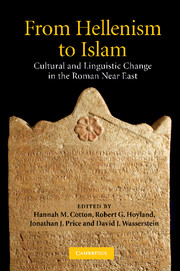Book contents
- Frontmatter
- Contents
- List of figures
- List of tables
- List of contributors
- Preface
- List of abbreviations
- Introduction: documentary evidence, social realities and the history of language
- Part I THE LANGUAGE OF POWER: LATIN IN THE ROMAN NEAR EAST
- Part II SOCIAL AND LEGAL INSTITUTIONS AS REFLECTED IN THE DOCUMENTARY EVIDENCE
- 3 Euergetism in Josephus and the epigraphic culture of first-century Jerusalem
- 4 Legal and social status of threptoi and related categories in narrative and documentary sources
- 5 Ritual performances of divine justice: the epigraphy of confession, atonement, and exaltation in Roman Asia Minor
- 6 Continuity of Nabataean law in the Petra papyri: a methodological exercise
- Part III THE EPIGRAPHIC LANGUAGE OF RELIGION
- Part IV LINGUISTIC METAMORPHOSES AND CONTINUITY OF CULTURES
- Part V GREEK INTO ARABIC
- Index
4 - Legal and social status of threptoi and related categories in narrative and documentary sources
Published online by Cambridge University Press: 01 March 2010
- Frontmatter
- Contents
- List of figures
- List of tables
- List of contributors
- Preface
- List of abbreviations
- Introduction: documentary evidence, social realities and the history of language
- Part I THE LANGUAGE OF POWER: LATIN IN THE ROMAN NEAR EAST
- Part II SOCIAL AND LEGAL INSTITUTIONS AS REFLECTED IN THE DOCUMENTARY EVIDENCE
- 3 Euergetism in Josephus and the epigraphic culture of first-century Jerusalem
- 4 Legal and social status of threptoi and related categories in narrative and documentary sources
- 5 Ritual performances of divine justice: the epigraphy of confession, atonement, and exaltation in Roman Asia Minor
- 6 Continuity of Nabataean law in the Petra papyri: a methodological exercise
- Part III THE EPIGRAPHIC LANGUAGE OF RELIGION
- Part IV LINGUISTIC METAMORPHOSES AND CONTINUITY OF CULTURES
- Part V GREEK INTO ARABIC
- Index
Summary
My on-going study of θρ∈πτός (threptos) and related categories in Greek narrative and documentary sources began as a study in terminology, but it inevitably grew into a study of legal, social and economic structures of Hellenistic Greece and the Roman east from 200 BCE to 300 CE. This study will include discussions about the origin and the legal and social status of children whose natural parents were unable or unwilling to raise them as their own, and the legal and social status of those who raised them. With nearly 1,200 inscriptions and papyri and a small sample of literary texts at our disposal, this project seems long overdue, especially in view of the growing number of important studies on the Roman family and the Latin correlative of Greek θρ∈πτοί (threptoi) – Roman and Italian alumni/nutriti.
Prior to A. Cameron's study, ‘ΘPEΠTOΣ and Related Terms in the Inscriptions of Asia Minor’, published in 1939, only sporadic references to this social group were to be found in modern literature. As Cameron himself put it, ‘no very systematic attempt has been made to determine their status or the nature of their relationships to other persons’ (p. 27). Teresa Giulia Nani took up the problem of θρ∈πτοί anew in a lengthy article published in 1944. She enlarged her field of study by including all the sources available at that time. She collected about 230 inscriptions featuring θρ∈πτοί, their natural families and their nurturers. Since the publication of these two studies, the question of θρ∈πτοί has been strangely neglected, although the amount of documentary evidence has more than doubled in the meantime.
- Type
- Chapter
- Information
- From Hellenism to IslamCultural and Linguistic Change in the Roman Near East, pp. 93 - 114Publisher: Cambridge University PressPrint publication year: 2009
- 11
- Cited by



